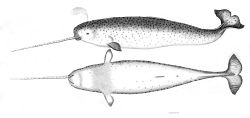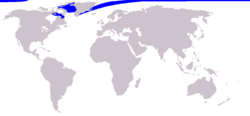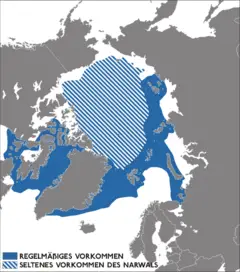Narwhal
| Narwhal [1] | ||||||||||||||||
|---|---|---|---|---|---|---|---|---|---|---|---|---|---|---|---|---|
  Size comparison with an average human
| ||||||||||||||||
| Scientific classification | ||||||||||||||||
| ||||||||||||||||
| Monodon monoceros Linnaeus, 1758 | ||||||||||||||||
 Narwhal range (in blue)
|
Narwhal is the common name for an Arctic whale, Monodon monoceros, of the cetacean suborder Odontoceti (toothed whales), characterized by mottled gray color, no dorsal fin, a long and low dorsal hump, a short head, and in males (and occasionally females) a single (rarely double) long, straight tusk, with a left-handed spiral groove. Narwhals have only two teeth, of which the left incisor in males typically forms the tusk. The narwhal is a creature rarely found south of latitude 70°N.
The narwhal also is known as the unicorn whale.
Overview and description
As toothed whales, comprising the suborder Odontoceti of the order Cetacea, the narwhal is characterized by the main bones of the upper jaw thrust upward and back over the eye sockets, only one blowhole, and teeth. In addition to whales, this suborder includes dolphins and porpoises as well. The narwhal (Monodon monoceros) is an Arctic species of cetacean. It is one of two species of white whale in the Monodontidae family (the other is the Beluga whale).
Narwhals are generally pale with brown speckles in color, though the neck, head, and edges of the flippers and fluke are nearly black. Older animals are usually more brightly colored than younger animals (FAO). Male narwhals weigh up to 1,600 kilograms (3,500 pounds), and the females weigh around 1,000 kilograms (2,200 pounds).
The most conspicuous characteristic of the narwhal is the male's single, extraordinarily long tusk. The narwhal has only two teeth, upper incisors. The tusk is an incisor tooth, typically the left one, that projects from the upper jaw and has a groove that forms a left-handed helix. The tusk may be 2.4 to 3 meters (8 to 10 feet) long (compared with a body length of 4 to 6 meters, or 13 to 16 feet)) and weigh up to 10 kilograms (22 pounds). About one in 500 males has two tusks, which occurs when the right incisor, normally small, also grows out. Occasionally a female narwhal may also produce a tusk, and there is a single recorded case of a female with dual tusks (Carwardine 1995).
The purpose of the tusk is unknown, though various explanations have been proposed. One explanation suggested is that the tusk is used to pierce the ice covering the narwhal's Arctic Sea habitat (Broad 2005). Another suggestion is that the tusk is used in echolocation. (Echolocation is an ability held by the toothed whales.) Other hypothesized uses include courting females, defense, and foraging for food. In yet another theory, the tusk is primarily used for showmanship and for dominance: males with larger tusks are more likely to successfully attract a mate. This hypothesis was suggested by the activity of "tusking," in which two males rub tusks.
However, recent work by a research team strongly suggests that the tusk may in fact be a sensory organ (HMS 2005). Electron micrographs of tusks revealed ten million tiny, deep tubules extending from the tusk's surface, apparently connecting to the narwhal's nervous system (SD 2005). While such tubules are present in the teeth of many species, they do not typically extend to the surface of healthy teeth. The exact sensory purpose of the tusk remains unknown, but scientists now hypothesize that it may detect temperature, salinity, pressure, or particulate makeup of the water environment (HMS 2005).
The narwhal was one of the many species originally described by Linnaeus in his Systema Naturae. The name is based on the Old Norse word nár, meaning "corpse," in reference to the animal's pigmentation. In some parts of the world, the narwhal is colloquially referred to as the moon whale or polar whale.
Population and distribution
The narwhal has a disjunct Arctic circumpolar distribution, with main concentrations in the Atlantic sector of the Arctic, from the northern Hudson Bay and Hudson Strait eastward to the Greenland Sea, and into the Russian Arctic (Jefferson et al. 2008; Grzimek et al. 2004). Individuals are commonly recorded in the northern part of Hudson Bay, Hudson Strait, and Davis Strait/Baffin Bay, off the east coast of Greenland, and in a strip running east from the northern end of Greenland round to eastern Russia (170° East). Land in this strip includes Svalbard, Franz Joseph Land, and Severnaya Zemlya. The northernmost sightings of narwhal have occurred north of Franz Joseph Land, at about 85° North latitude. Narwhals are rarely seen in Alaska, the far eastern Russian Arctic, or the western Canadian Arctic (Jefferson et al. 2008).
Narwhals tend to inhabit deep marine waters; in the summer (about two months) they spend time in the ice-free, inshore, shallow bays and fjords, while overwintering in offshore, deep, ice-covered zones along the continental slope (Jefferson et al. 2008; Grzimek et al. 2004). They migrate annually (about two months migratory time) between these two disjunct seasonal habitats (Jefferson et al. 2008). In summer months, they move closer to coasts, usually in pods of 10 to 100. As the winter freeze begins, they move away from shore, and reside in densely-packed ice, surviving in leads and small holes in the ice. As spring comes, these leads open up into channels and the narwhals return to the coastal bays.
The world population is currently estimated to be around 80,000 individuals of all ages by the International Union for Conservation of Nature and Natural Resources (IUCN) (Jefferson et al. 2008). Some list the population size as 40,000 (Grzimek et al. 2004) to 50,000 (Milius 2006).
Behavior and diet
Narwhals are quick, active mammals that feed mainly on cod, squid, shrimp and halibut (Jefferson et al. 2008; Laidre and Heide-Jørgensen).
In some areas, their diet seems to have adapted to include different squid, shrimps, and various fish, such as schooling pelagics, halibuts, and redfishes. When food is scarce, narwhals will even eat baby seals.
There are indications that much of the feeding takes place in the wintering grounds, when intense benthic feeding has been documented, versus low feeding during the summer period (Jefferson et al. 2008).
Narwhals normally congregate in groups of about five to ten. Sometimes several of these groups might come together, particularly in summer when they congregate on the same coast.
Narwhals generally prefer deep waters offshore in all areas of their occurrence (Jefferson et al. 2008), but tend to stay near the surface. During a typical deep dive, the animal will descend as fast as 2 meters per seconds for eight to ten minutes, reaching a depth of at least 1,500 meters (5,000 feet), spending perhaps a couple of minutes at depth before returning to the surface.
Tusking
At times, male narwhals rub one another's tusks together in an activity called "tusking." Because of the tusk's high sensitivity, the males may engage in tusking for its unique sensation. The tusking may also simply be a way of clearing encrustations from the sensory tubules, analogous to brushing teeth.
Predation and conservation
The main predators of narwhals polar bears and orcas (killer whales), although Greenland sharks and walruses (Jefferson et al. 2008).
Inuit people are allowed to hunt this whale species legally. The northern climate provides little nutrition in the form of vitamins, which can only be obtained through the consumption of seal, whale, and walrus. The livers of these animals are often eaten immediately following the killing by the hunting party in an ancient ceremony of respect for the animal. Nawhals also have been used by the Inuit for dog food and tusk ivory (Jefferson 2008)..
In Greenland, traditional hunting methods in whaling are used (such as harpooning), but high-speed boats and hunting rifles are frequently used in Northern Canada. According to Jefferson et al. (2008), narwhals have never been the target of large-scale commercial hunting, with the exception of several decades in the 20th century in the eastern Canadian Arctic, although they have been hunted opportunistically. They also maintain that today it also is actively hunted only in Canada and Greenland.
Cultural references
In Inuit legend, the narwhal was created when a woman holding onto a harpoon had been pulled into the ocean and twisted around the harpoon. The submerged woman was wrapped around a beluga whale on the other end of the harpoon.
Some medieval Europeans believed narwhal tusks to be the horns from the legendary unicorn (Daston and Park 2001). As these "horns" were considered to have magic powers, Vikings and other northern traders were able to sell them for many times their weight in gold. The tusks were used to make cups that were thought to negate any poison that may have been slipped into the drink. During the 16th century, Queen Elizabeth received a carved and bejeweled narwhal tusk for £10,000—the cost of a castle (approximately £1.5—2.5 million in 2007, using the retail price index (Officer 2008)). he tusks were staples of the cabinet of curiosities.
The truth of the tusk's origin developed gradually during the Age of Exploration, as explorers and naturalists began to visit Arctic regions themselves. In 1555, Olaus Magnus published a drawing of a fish-like creature with a "horn" on its forehead.
Notes
| Cetaceans Portal |
- ↑ J. G. Mead, and R. L. Brownell, "Cetacea," pages 723-743 in D. E. Wilson and D. M. Reeder, eds., Mammal Species of the World, 3rd edition. (Johns Hopkins University Press, 2005). ISBN 0801882214.
- ↑ T. A. Jefferson, L. Karczmarski, K. Laidre, G. O’Corry-Crowe, R. R. Reeves, L. Rojas-Bracho, E. R. Secchi, E. Slooten, B. D. Smith, J. Y. Wang, and K. Zhou, "Monodon monoceros," in 2008 IUCN Red List of Threatened Species (Gland, Switzerland: IUCN, 2008). Retrieved December 14, 2008.
ReferencesISBN links support NWE through referral fees
.[2]
Grzimek et al.
.[6]
Marine Biology Mystery Solved: Function of "Unicorn" Whale's 8-foot Tooth Discovered
Harvard School of Dental Medicine Researcher Announces Findings Today
[8]
Marine Biology Mystery Solved: Function Of 'Unicorn' Whale's 8-foot Tooth Discovered
ScienceDaily (Dec. 14, 2005)
- Jefferson, T. A., L. Karczmarski, K. Laidre, G. O’Corry-Crowe, R. R. Reeves, L. Rojas-Bracho, E. R. Secchi, E. Slooten, B. D. Smith, J. Y. Wang, and K. Zhou. 2008. Monodon monoceros. In IUCN, 2008 IUCN Red List of Threatened Species. Retrieved December 14, 2008.
- Mead, James G. and Robert L. Brownell, Jr (November 16 2005). in Wilson, D. E., and Reeder, D. M. (eds): Mammal Species of the World, 3rd edition, Johns Hopkins University Press, 723-743. ISBN 0-801-88221-4.
[10]).
- General references
- "Narwhal". M. P. Heide-Jorgensen (pp 783–787), in Encyclopedia of Marine Mammals, Perrin, Wursig and Thewissen eds. ISBN 0-12-551340-2
- Narwhal general information
- Narwhal Tooth Expedition and Research Investigation
- Narwhal info
- "Narwhal Found to Have a Trick Up Its Tusk", Scientific American News
External links
- Narwhal Whales Information and images
Galleries
- Paul Nicklen, Canada National Geographic Magazine
- On National Geographic
Credits
New World Encyclopedia writers and editors rewrote and completed the Wikipedia article in accordance with New World Encyclopedia standards. This article abides by terms of the Creative Commons CC-by-sa 3.0 License (CC-by-sa), which may be used and disseminated with proper attribution. Credit is due under the terms of this license that can reference both the New World Encyclopedia contributors and the selfless volunteer contributors of the Wikimedia Foundation. To cite this article click here for a list of acceptable citing formats.The history of earlier contributions by wikipedians is accessible to researchers here:
The history of this article since it was imported to New World Encyclopedia:
Note: Some restrictions may apply to use of individual images which are separately licensed.
- ↑ Template:"It's Sensitive. Really". William J. Broad, New York Times, 13 December 2005, http://nytimes.com/2005/12/13/science/13narw.html / NYT article RSS link
- ↑ Carwardine, Mark (April 1995). DK Handbooks: Whales Dolphins and Porpoises. Dorling Kindersley. ISBN 1564586200.
- ↑ Daston, Lorraine and Katharine Park. Wonders and the Order of Nature, 1150-1750. New York: Zone Books, 2001.
- ↑ [http://www.fao.org/fi/website/FIRetrieveAction.do?dom=species&fid=2742 Species Fact Sheets Monodon monoceros (Linnaeus, 1758)]. Fisheries and Aquaculture Department: Species Fact Sheets. Food and Agriculture Organization of the United Nations. Retrieved 2007-11-20.
- ↑ Marine Biology Mystery Solved: Function of "Unicorn" Whale's 8-foot Tooth Discovered. Harvard Medical School (13 December 2005). Retrieved 2008-04-27.
- ↑ The Biology and Ecology of Narwhals. National Oceanic and Atmospheric Administration. Retrieved 2008-09- The Biology and Ecology of Narwhals Dr. Kristin Laidre, Polar Science Center Applied Physics Lab, University of Washington Dr. Mads Peter Heide-Jørgensen Greenland Institute of Natural Resources.
- ↑ Milius, Susan and Martin Nweeia (25 March 2006). That's One Weird Tooth. Science News 169 (12). ISSN 0036-8423.
- ↑ http://www.sciencedaily.com/releases/2005/12/051214081832.htm
- ↑ (Latin) Linnaeus, C (1758). Systema naturae per regna tria naturae, secundum classes, ordines, genera, species, cum characteribus, differentiis, synonymis, locis. Tomus I. Editio decima, reformata.. Holmiae. (Laurentii Salvii)., 824.
- ↑ Purchasing Power of British Pounds from 1264 to 2007 Lawrence H. Officer, "Purchasing Power of British Pounds from 1264 to 2007," MeasuringWorth, 2008. URL http://www.measuringworth.com/ppoweruk/







